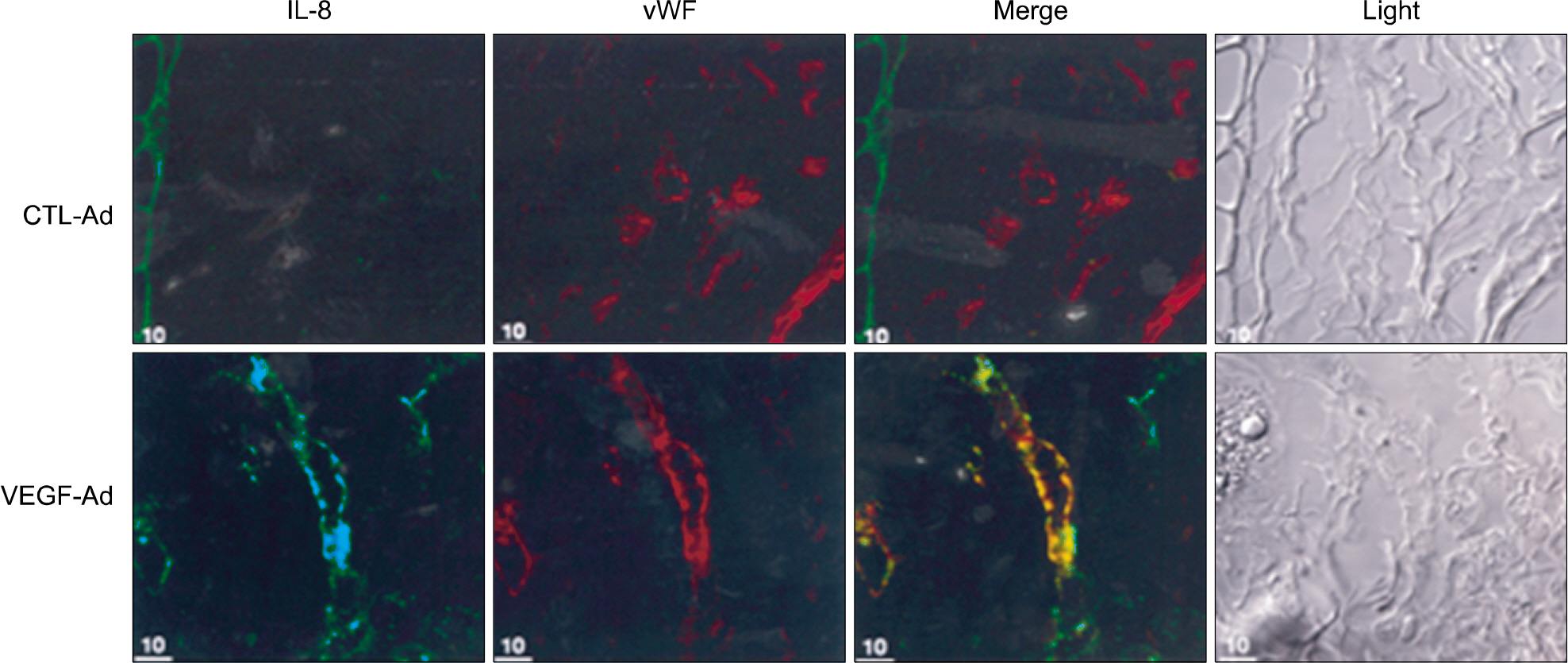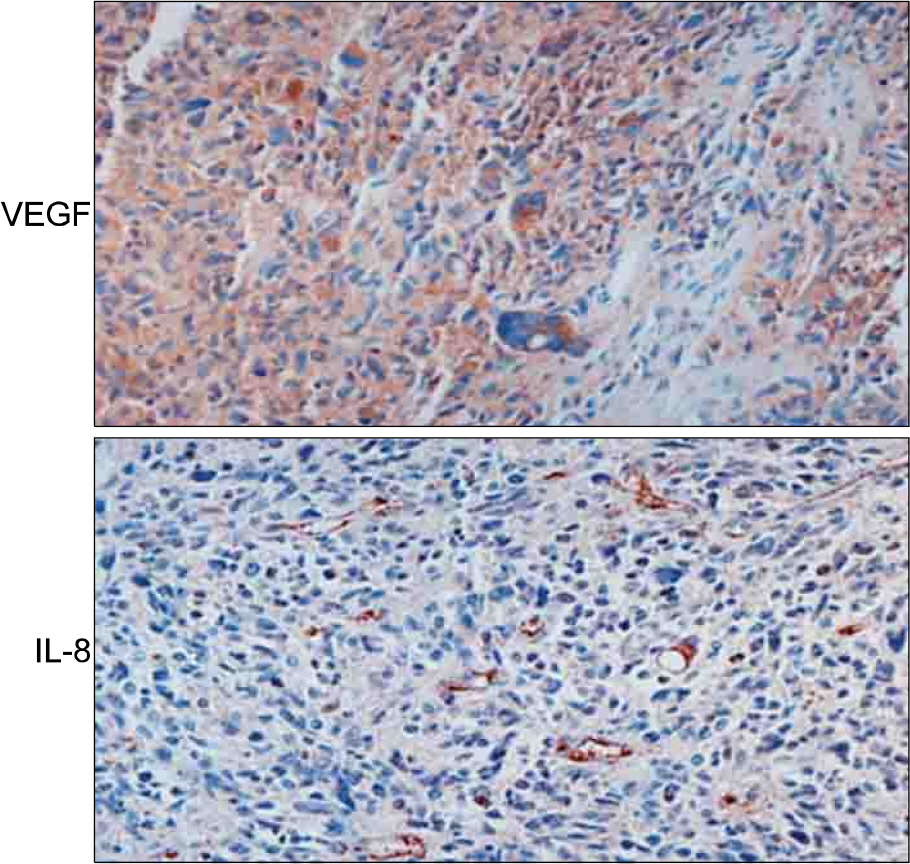Korean J Hematol.
2009 Dec;44(4):199-204. 10.5045/kjh.2009.44.4.199.
Up-regulation of Interleukin-8 by Vascular Endothelial Growth Factor in Vasculatures in vivo
- Affiliations
-
- 1Thrombosis and Vascular Biology Lab., Department of Medical Science, CHA University, Seongnam, Korea. hoe@cha.ac.kr
- 2Laboratoryof Cancer & Stem Cell Biology, Natural Science Institute, Yonsei University, Seoul, Korea.
- KMID: 2252097
- DOI: http://doi.org/10.5045/kjh.2009.44.4.199
Abstract
- BACKGROUND
Vascular endothelial growth factor (VEGF) plays an essential role in promoting angiogenesis during tumor development. In addition, VEGF can mediate the inflammatory response in tumors. VEGF increases the level of neutrophil migration by upregulating interleukin-8 (IL-8) in endothelial cells in vitro. However, it is unclear if VEGF can mediate IL-8 production in vivo. METHODS: To address this issue, this study examined the effect of VEGF on IL-8 production in vivo using an adenovirus transduction and mouse ear assay. RESULTS: Adenovirus-encoded VEGF (VEGF-Ad) increased the level of IL-8 production in endothelial cells in vitro compared to the control-adenovirus (CTL-Ad). The mouse ear assay showed that VEGF-Ad increased the level of IL-8 production in the endothelium. Immunohistochemistry showed that the IL-8 proteins were expressed in the vasculature within a human glioblastoma, which is known to strongly express VEGF. CONCLUSION: These results suggest that VEGF can mediate the inflammatory response in endothelial cells in vivo via the up-regulation of IL-8.
Keyword
MeSH Terms
-
Adenoviridae
Animals
Ear
Endothelial Cells
Endothelium
Glioblastoma
Humans
Immune System Diseases
Immunohistochemistry
Inflammation
Interleukin-8
Leukocyte Disorders
Mice
Neutrophils
Proteins
Up-Regulation
Vascular Endothelial Growth Factor A
Immune System Diseases
Interleukin-8
Leukocyte Disorders
Proteins
Vascular Endothelial Growth Factor A
Figure
Reference
-
References
1. Hicklin DJ, Ellis LM. Role of the vascular endothelial growth factor pathway in tumor growth and angiogenesis. J Clin Oncol. 2004; 23:1011–27.
Article2. Cai J, Ahmad S, Jiang WG, et al. Activation of vascular endothelial growth factor receptor-1 sustains angiogenesis and Bcl-2 expression via the phosphatidylinositol 3-kinase pathway in endothelial cells. Diabetes. 2003; 52:2959–68.
Article3. Senger DR, Perruzzi CA, Feder J, Dvorak HF. A highly conserved vascular permeability factor secreted by a variety of human and rodent tumor cell lines. Cancer Res. 1986; 46:5629–32.4. Berkman RA, Merrill MJ, Reinhold WC, et al. Expression of the vascular permeability factor/vascular endothelial growth factor gene in central nervous system neoplasms. J Clin Invest. 1993; 91:153–9.
Article5. Boocock CA, Charnock-Jones DS, Sharkey AM, et al. Expression of vascular endothelial growth factor and its receptors flt and KDR in ovarian carcinoma. J Natl Cancer Inst. 1995; 87:506–16.6. Brown LF, Berse B, Jackman RW, et al. Expression of vascular permeability factor (vascular endothelial growth factor) and its receptors in breast cancer. Hum Pathol. 1995; 26:86–91.
Article7. Kim KJ, Li B, Winer J, et al. Inhibition of vascular endothelial growth factor-induced angiogenesis suppresses tumour growth in vivo. Nature. 1993; 362:841–4.
Article8. Ferrara N, Davis-Smyth T. The biology of vascular endothelial growth factor. Endocr Rev. 1997; 18:4–25.
Article9. Thomas AL, Morgan B, Drevs J, et al. Vascular endothelial growth factor receptor tyrosine kinase inhibitors: PTK787/ZK 222584. Semin Oncol. 2003; 3:32–8.
Article10. Nagy JA, Dvorak AM, Dvorak HF. VEGF-A and the induction of pathological angiogenesis. Annu Rev Pathol. 2007; 2:251–75.
Article11. Falanga A, Panova-Noeva M, Russo L. Procoagulant mechanisms in tumour cells. Best Pract Res Clin Haematol. 2009; 22:49–60.
Article12. Nelson PJ, Krensky AM. Chemokines, chemokine receptors, and allograft rejection. Immunity. 2001; 14:377–86.
Article13. Marumo T, Schini-Kerth VB, Busse R. Vascular endothelial growth factor activates nuclear factor-kappaB and induces monocyte chemoattractant protein-1 in bovine retinal endothelial cells. Diabetes. 1999; 48:1131–7.
Article14. Lee TH, Avraham H, Lee SH, Avraham S. Vascular endothelial growth factor modulates neutrophil transendothelial migration via upregulation of interleukin-8 in human brain microvascular endothelial cells. J Biol Chem. 2002; 277:10445–51.
Article15. Lee TH, Seng S, Sekine M, et al. Vascular endothelial growth factor mediates intracrine survival in human breast carcinoma cells through intenally expressed VEGFR1/FLT1. PLoS Med. 2007; 4:e186.16. Senger DR, Galli SJ, Dvorak AM, Perruzzi CA, Harvey VS, Dvorak HF. Tumor cells secrete a vascular permeability factor that promotes accumulation of ascites fluid. Science. 1983; 219:983–5.
Article
- Full Text Links
- Actions
-
Cited
- CITED
-
- Close
- Share
- Similar articles
-
- Expression of Vascular Endothelial Growth Factor : Clinical Implications in Cervical Neoplasia
- Zerumbone, Sesquiterpene Photochemical from Ginger, Inhibits Angiogenesis
- Serum vascular endothelial growth factor as a marker of asthma exacerbation
- Expression of Vascular Endothelial Growth Factor and Peritumoral Brain Edema in Intracranial Meningiomas
- Vascular Endothelial Growth Factor Expression in Human Trohoblast Cell Line





